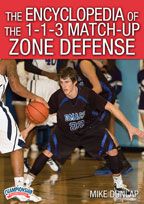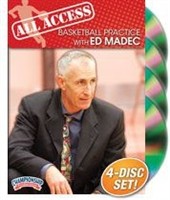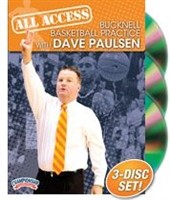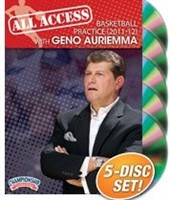Description
with Mike Dunlap,
former Charlotte Bobcats (NBA) Head Coach;
former Assistant Coach at St. Johns University;
former Metropolitan State College Head Coach;
2x NCAA Division II National Champion (2000, 2002), NABC Division II Coach of the Year (2000, 2002)
Break the rhythm of your opponent’s offense with this unique ball hawking and trapping match-up zone defense.
Mike Dunlap, master of the 1-1-3 Match-up Zone, takes you through a detailed process on how to implement the 1-1-3 match-up zone into your defensive philosophy. After researching through several coaches that have had success with the 1-1-3, Coach Dunlap has complied his own version of the 1-1-3, which is based upon man-to-man principles. Dunlap takes you through how he trains his players to pressure the ball relentlessly, teaching you his five trademarks of the 1-1-3 match-up zone: stance and hands, jumping to the ball, communication, rebounding, and ball pressure/pressuring the neutral zone.
As he discusses the five trademarks of the 1-1-3, Coach Dunlap goes in detail as to how he trains his players and the simple drills he uses to stress the importance of applying great ball pressure in order to break the rhythm of the offensive player. In order for this defense to have its desired effect, the on-ball defender must be pressuring the ball and making things uncomfortable. Central to this component is the notion of taking away the offensive player’s ‘6 inch window.’ This is the space that offensive players typically operate from and Dunlap teaches his players to disrupt this neutral zone.
Coach Dunlap then takes his players through stance, hands and jumping to the ball. The main concept regarding technique is to constantly trace the line of the ball with active hands and to maintain a square stance that is even with the line of the ball. He has his players keep their hands high so that a shooter does not get comfortable bringing ball up to shoot. The head should be in line with the ball in order to better trace the ball. Dunlap talks about jumping to the ball in order to create great defensive spacing. Defensive spacing is all five guys working as one and moving as one on the flight of the ball. He uses a simple jump to the ball drill, but makes his players go to the extreme by going from one side of the floor to the other in order to build an atmosphere of extreme defense.
The last two trademarks Dunlap discusses are communication and rebounding. When players are faced with intense in-game pressure, communication is the first thing that team’s struggle to maintain. As such, Dunlap stresses the significance of teaching players to communicate incessantly during practice. He trains his players to use short one word specific calls in order to communicate with each other. The final point that Dunlap stresses is rebounding the basketball. This is perhaps the most important aspect of the defense as it is the concept that indicates whether the defense has closed out a defensive possession or not. He teaches his players to rebound out of a triangle while having a “sweeper” go to the weakside and solidify where most of the shots come off the rim. He trains his players to play the percentages when it comes to rebounding. He believes solidifying the weakside will allow for a greater advantage in rebounding.
Technical Aspects of the 1-1-3 Defense
Following the major teaching points of the 1-1-3, Coach Dunlap examines several technical aspects of the match-up zone defense. He starts by showing his players how to closeout whether it be a long or a short closeout. He teaches his players to use a cheat step and whip their opposite leg around in order to closeout quicker. Dunlap discusses how they side pin the dribbler in order to prevent ball reversal. He teaches his players to keep the ball in the alley as long as possible in order to make the player feel uncomfortable.A major part to teaching the 1-1-3 matchup zone is what Dunlap calls counting the sideline alleys. This helps his players know how to rotate and how to set up their match ups. He breaks down what to do if there are one, two or three players in the alley. He also discusses what to do if a your forwards make the mistake of closing out to the first pass instead of your guards.
Coach Dunlap finishes his technical breakdown by showing you how to defend different positions based on your opponents strengths. He takes you through guard and forward rotation to master the elbow defense (the elbow is critical to beating any zone). If your opponent is a post first team, he takes you through how to front the post and double or triple the post player when he catches. If your opponent is great at dribble penetration, Dunlap shows you how to use the 1-1-3 zone rotations to stunt and trap out of dribble penetration. Finally, Mike takes you through several difficult situations out of the 1-1-3 that are sure to help you shut down any counter your opponent has.
This video tutorial of the 1-1-3 Match-up Zone is a must have for any coach looking to learn or implement zone principles. All aspects from A-Z are covered in a very efficient and informative way, from on court player instruction, to chalkboard presentation, to in-game highlights. Every fundamental detail is explained, along with the reasoning behind it, and supporting information such as statistical analysis is further provided as support. The strategies outlined in this presentation allowed Metro State College to hold its opponents to under 60 points per game.
Apply the 1-1-3 defense this season to disrupt offensive flow, lower opponents’ shooting percentage and increase opponents’ turnovers!
83 minutes. 2012.




